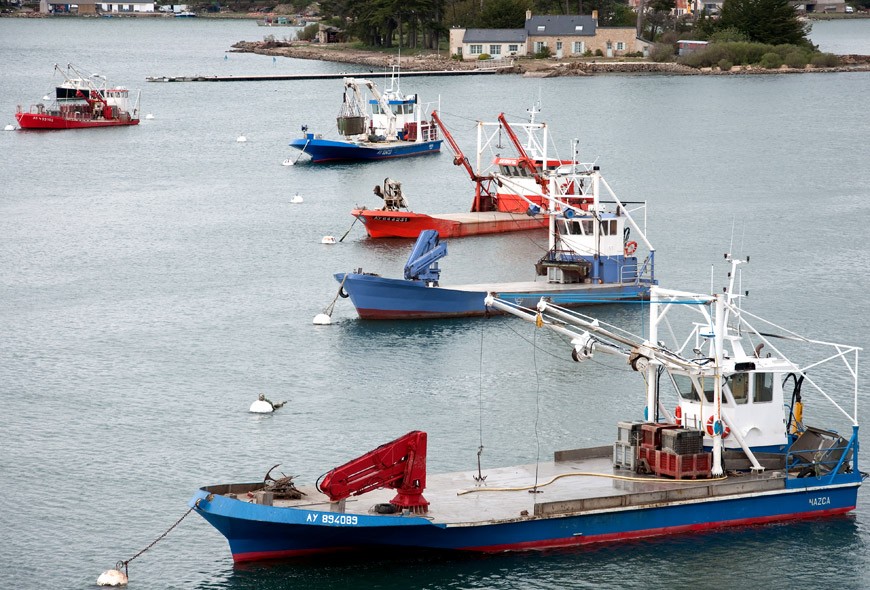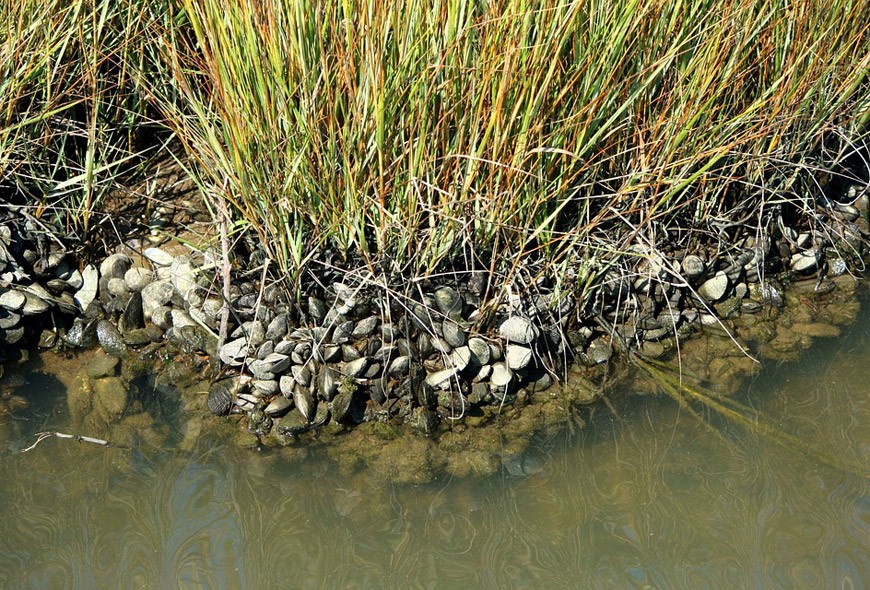It’s estimated commercial fishing reached its peak back in the 1990s. If you’ve heard the phrase peak oil, know the message here is the same. We’ve reached the point of no return when it comes to our appetite for fish and other marine life, and if we don’t take extreme measures to curb the problem, the effects could be devastating.
Before fishing reached critical levels, oysters in the Chesapeake Bay and other harbors, such as the Hudson River and New York Harbor, relied on these mollusks to maintain the cleanliness of public waters. A healthy oyster population means a healthier environment—for every type of animal that lives there (including human beings). But oysters have been in decline for decades.
At one point in time, the oyster population in the Chesapeake Bay had fallen to just one percent of where it once was — a historic low and one that cannot be repeated. The problem oysters are facing, in plain terms, is that they’ve been treated like a renewable resource for far too long. Restoring the oyster population at this key moment begins with our recognizing this creature as an invaluable — and finite — resource, and one that cannot be taken for granted.
It’s no secret overfishing is a significant and growing problem. Major news outlets have been spreading the word about it for years now. The trouble is, without an obvious and personal reason to care, Americans frequently find little motivation to change their ways.
The path before us is clear: The public needs its consciousness raised about the important role oysters play in local ecosystems. By spreading awareness about overfishing and pollutants, and by committing to eating less shellfish, we can, together, ensure that the oysters in Chesapeake Bay and beyond are still around for our children’s children to enjoy.
The State of the Bay
In the 400 years since John Smith first sailed its waters, the Chesapeake Bay has seen the high cost of American appetites. By 1980, 4.4 million acres of heretofore unmolested land saw commercial development. The area has lost half of its forested shoreline and wetlands, 80 percent of its underwater grasses, and a staggering 98 percent of its population of oysters. All of these factors have combined to create sweeping negative effects on the environment and the people who call it home.
But let’s narrow our focus just a bit. It turns out oysters are a key player in this growing ecological disaster, as well as the subject of widespread rehabilitation efforts. Let’s take a look at just how important oysters are to the area.
The Plight of the Oyster
In 1609, when Henry Hudson was navigating New York Harbor, roughly 220,000 acres of the “Half Moon” were occupied by oyster reefs. The Native American tribe known as the Lenape relied upon this area for sustenance, as did thousands of plant and animal species. It’s been called one of the most biologically productive and diverse environments anywhere on planet earth.
By 1906, however, New York Harbor was virtually lifeless, with its waters polluted nearly beyond recognition. A significant reason for this dramatic transformation was New York’s insatiable appetite for oysters, which had depleted the area’s entire supply of the mollusks.
To put it plainly, sky-high demand for oysters is what landed us in this situation. But the diminishing population is just one facet of the larger problem. Restaurants have also contributed to local pollution by dumping empty oyster shells in landfills rather than returning them (and their nutrients) back to the ocean environment from whence they came.
Thankfully, the Billion Oyster Project (BOP) has an innovative solution to this systemic problem.
According to current Director of the Billion Oyster Project (BOP), Pete Malinowski, BOP collects from numerous restaurants that are actively involved in returning the shells back to the coasts such as Aquagrill, Bagatelle, Bar Sardine, Blue Ribbon Brooklyn, Blue Smoke Flatiron, Blue Water Grill, Brooklyn Crab, Brooklyn Oyster Party, Brooklyn Lighthouse, Catch NYC, Ed’s Chowder House, Eataly, Eleven Madison Park, Fedora, Jeffrey’s Grocery, Oceana, Measure, The Lobster Place, to name a few.
How Do Oysters Keep Our Waters Clean?
But to understand the full magnitude of the problem, we need to better understand the oyster’s unique gifts for filtering and restoring water itself. It turns out oysters, as well as mussels and snails, serve as tiny waste processing plants, and they’re exceptionally efficient about it.
Malinowski says, “Oysters are a keystone species.” He further explains, “Oysters have a disproportionate positive effect on their ecosystem. Like coral, oysters provide habitat for thousands of other fish and invertebrates.”
These mollusks effectively filter the water in their habitat as they hunt around for the microscopic organisms they rely on for food, called phytoplankton. Oysters and other bivalves are so named because they take in water, strip it of contaminants and food, and release “treated” water back into the environment.
Research conducted using water tanks in laboratories revealed oysters are capable of cleaning as much as 80 percent of contaminants from their surroundings in as little as 72 hours. What “contaminants” are we talking about here? The list includes:
- Herbicides
- Pesticides
- Flame retardants
- Harmful bacteria
- Pharmaceuticals
In short, we’re not just harming the oysters by depleting their population to near-extinction levels. We’re also endangering ourselves by removing one of the most effective water treatment apparatus available to us right now.
And the difference can sometimes be stunning. The water quality has visibly worsened in the Chesapeake Bay and New York Harbor in the past few decades. But in areas where oysters have been reintroduced in larger numbers, the change can be dramatic, resembling the sparkling waters the Native American tribes likely took for granted hundreds of years ago.
How Activists Are Turning Things Around
The North Atlantic was once the world’s oyster capital, and it can be once again if we take bold steps forward and do what needs to be done. Malinowski adds to this by saying that The Billion Oyster Project has set an audacious goal. He tells us, “BOP is an ecosystem restoration and public education initiative aimed at restoring one billion live oysters around New York Harbor and engaging hundreds of thousands of school children through restoration based STEM education programs.”
So far, things are off to a great start. The project boasts of having delivered 11,500,000 live oysters so far, filtered nearly 20 trillion gallons of water, leeched 72,500 pounds of nitrogen, and recycled more than 250,000 pounds of oyster shells.
In addition to helping to restore oyster reefs, the Chesapeake Bay Foundation has partnered with farmers in the Baltimore area to help reduce pollution in the form of pesticides and insecticides, which have also done their part to worsen the condition of the Bay area. In the absence of a sufficient oyster population, these pesticides don’t stand much of a chance of being removed from the environment in a timely manner, creating a cascade effect that threatens other animal life in the area.
The Virginia Aquarium has also taken steps to help reverse this trend. In the summer of 2015, the aquarium built a brand new oyster reef on the premises and stocked it with more than 18,000 young oysters. The mollusks were raised in a joint effort by Old Donation Center School, New Castle Elementary School and Princess Anne Middle School.
Chris Witherspoon, the Director of Education for the Virginia Aquarium & Marine Science Center, tells MiLLENNiAL, “Because the reed is so accessible, we anticipate that schools will continue to visit each Spring to add their spat.”
The new reef serves not just as a proof of concept for the filtration abilities of oysters but also as an educational experience to help raise awareness of this ongoing problem — as well as the potential solutions — in the nearby population.
Witherspoon also says that the last step in this project is to add labels on the deck that explain the value of oysters and oyster reefs to healthy waterways and to biodiversity. She says, “the Aquarium is planning a long-term monitoring project to examine the impact of the reef structures on oyster colonization and changes to the shoreline.”
Pursuing a Solution
It’s clear now this oyster problem did not arise overnight, and it won’t be solved overnight, either. But thanks to the tireless efforts of these and other organizations, the oyster populations in these troubled areas are on the rise again for the first time in decades.
We’re on our way back not just from a devastating oyster shortage but also from leaving behind a sad legacy in the form of murky and polluted waterways. On this and many other fronts, the American people are slowly salvaging the inheritance we’ll be leaving behind for our children — in the form of a more verdant, balanced and thriving earth.
The efforts that have been made in order to try and restore this once abundant population have been in place, but as Pete tells us, “the 16.5 million oysters restored by BOP represent only a tiny fraction of the historical abundance.”
However, he does add to this comment by telling us, “Even though more work needs to be done, this practice of recycling and restoring has led to rapid and dramatic increases in local biodiversity as a direct result of reef installations. There have been significant reductions in Chlorophyll concentrations demonstrating the oyster’s role in mitigating the excess nitrogen that enters the system on a daily basis through our water waste treatment plants.”
Even though these changes and healthy practices have shown significant improvements for our Oyster species and the marine lives that are directly affected by their roles in the ecosystem, it is absolutely crucial to encourage seafood restaurants to ship oyster shells to coastal programs.



